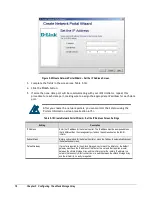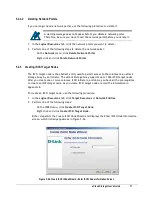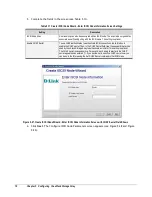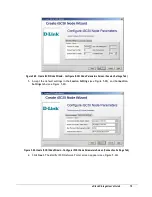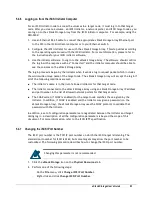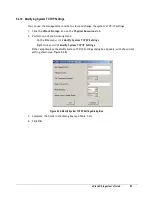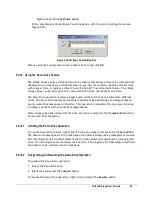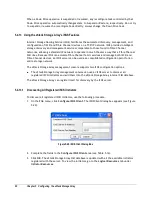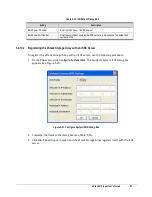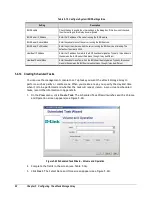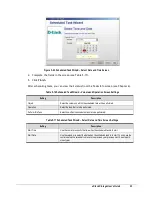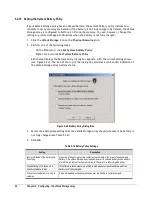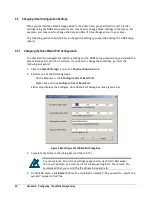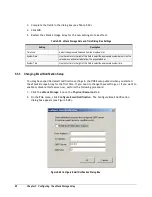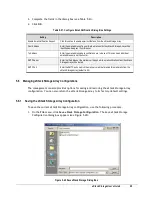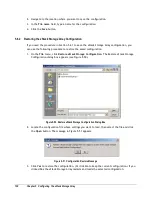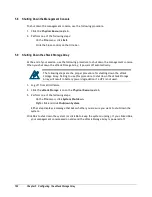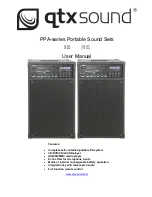
88
Chapter 5 Configuring the xStack Storage Array
Table 5-13 Modify System TCP/IP Settings Dialog Box Settings
Setting
Description
Max Segment Size
Indicates the maximum size TCP segment that can be accepted on a TCP/IP
connection when the connection is established.
Window Scale
Lets you use large windows during TCP/IP connections. On fast, high-bandwidth
networks, a large TCP window provides greater efficiency by allowing for a greater
amount of unacknowledged data.
TCP Timestamp Enabled
Causes the receiving computer to send a time-stamp reply back to the originating
computer. Systems can use time-stamp requests and replies to measure the
transmission speed of datagrams on a network.
Time to Live (TTL)
Specifies the default time to live (TTL) value for IP packets generated by the Windows
TCP/IP stack.
PMTU Enabled
Lets the xStack Storage Array automatically adapt its packet size. Disabling this option
forces the system to keep its default packet size (576 bytes), even when it receives an
ICMP request to change its packet size; this can render some remote systems
unreachable, because if intermediate systems on the path to the remote system cannot
support the default packet size, the xStack Storage Array ignores their requests to make
the packets smaller.
Upper Layer Count Reset
Resets the TCP/IP upper layer counters. Resetting the counters simplifies the ability to
look at the counters for an accurate percentage of packets sent or received.
5.4.11
Setting the Spare Count
A spare is a drive that is present in the system (in the
Available Pool
) that cannot be used for
any reason, except to rebuild space used by a volume on a failed drive. If a drive fails, the xStack
Storage Array tries to find a replacement extent for every extent on that failed drive that was
part of a redundant volume. First, a replacement extent is sought on a drive in the volume’s pool
(currently, the
Blade A Base Pool
). If space is not found in that pool and a drive exists in the
Available Pool
, one drive is obtained from the
Available
Pool
and an extent is selected from that
drive. In either case, a rebuild task starts to rebuild the volume’s extent. If the available pool is
empty, some volumes may not be rebuilt. The spare count exists to reduce that likelihood.
The spare count default is 0, which means that no drives are kept in reserve for use in rebuilding
extents (i.e., all drives can be obtained from the
Available Pool
for any purpose). Automatic
Volume Creation, for example, takes drives from the
Available Pool
automatically as needed to
satisfy the parameters in the request. If the spare count is set to a non-zero value, that number
of drives is retained in the
Available Pool
for use only for rebuilds (i.e., operations other than
rebuild cannot take a drive from the
Available Pool
if taking that drive results in the
Available
Pool
having fewer drives than the spare count value). For example, assume that the spare count
is one in an enclosure with 12 drives installed. If the administrator tried to perform an Automatic
Volume Creation with both sliders at 10 (their maximum values), the volume is created using 11
drives, without touching the twelfth. If a drive fails, the twelfth drive moves automatically from
the
Available Pool
to the volume’s pool, so its space can be used to rebuild the original failed
extent.
1.
Click the
xStack Storage
icon on the
Physical Resources
tab.
2.
Perform one of the following steps:
–
On the
File
menu, click
Set Spare Count
.
Summary of Contents for DSN-3400-10 - xStack Storage Area Network Array Hard...
Page 10: ...x Contents...
Page 20: ...20 Chapter 2 Identifying Hardware Components Figure 2 6 Press Lever Inwards Until it Locks...
Page 36: ......
Page 44: ...44 Chapter 4 Starting the xStack Storage Array for the First Time...
Page 103: ...xStack Storage User s Guide 103...
Page 117: ...xStack Storage User s Guide 117 Figure 6 12 Viewing SMART Attributes...
Page 160: ...160 Appendix D Replacing and Upgrading FRUs...
Page 164: ...164 Appendix F Hardware Enclosures...



